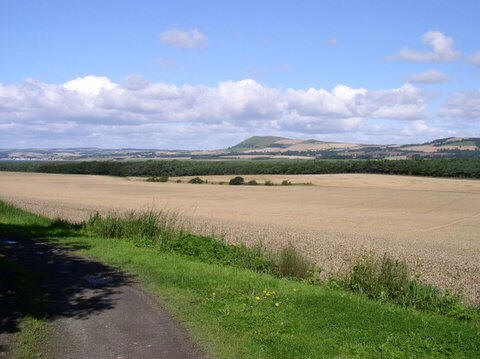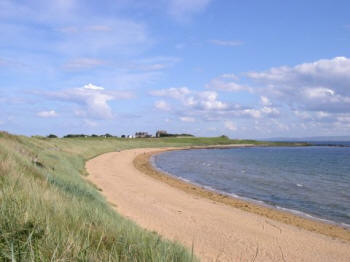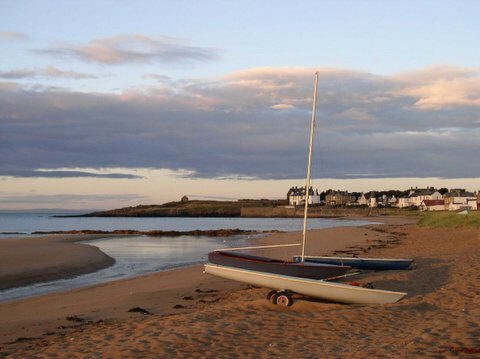|
Autumn
"Season of
Mists and Mellow Fruitfulness"
John Keats said it well.

Looking
towards Largo Law. The gravel path leads to Shell Bay.
What glorious months are September and
October.
Earlsferry now belongs to those who make
it their home all year round.
Children are now all back in school and
the summer visitors and the owners of holiday houses have all gone
back to the big cities. The streets are now noticeably clear of the
vehicles that lined the sidewalks during the months of summer.
Serenity arrives as the feel and the sounds
of autumn fill the air. Soon the snows of an early winter
may fall.
The flowers in the garden are well on the
wane. The leaves turn color and return to the earth from whence they came. The roses on the
walls and the trellises are past their best. Time to get out the
pruning shears and cut everything back and do the garden clean up before
the winter does come.
As the smoke of the garden bonfire
rises it goes vertically straight up into the windless air. I can
almost smell the fragrant reek. After the clean up it's time to
fertilize the garden and put it to sleep until next spring. Our garden
grew everything in profusion. Fertilizing our garden consisted of every
member of our family taking large potato sacks and wheel barrows and
heading to the beach to gather tangles that storms at sea had deposited on to
the tide line. A layer of tangles was spread on top of the
ground for the winter rains to leach the nutrients down into the soil. Next spring
what was left of the decomposing tangles would be lightly hoed under.
The local farmers also appreciated the value of the sea tangles that the
sea deposited on to the beach and with their horses, carts and tractors
they loaded and hauled away many tons of these tangles to fertilize
their farm fields.
The sun at mid-day is now noticeably lower on
the horizon. Beach huts that housed deck chairs, bathing suits,
towels, kites and sand castle building pails, that dotted the beach
during the months of summer, have all been taken apart and removed
for the season. Bob Haig and his ponies and donkeys have all gone
home till next year. Boats are being hauled up from their summer
moorages to spend the winter on dry land.
The Earlsferry beach, the West Sea beach
and Shell Bay beach are now all empty except for the few
villagers and their dogs that walk the tide lines.

West
Bay
The commercial salmon fishers have hauled
out their nets and stored them in the Granary at the Elie harbour
until next spring.
The golf course is no longer crowded and play slows to a leisurely pace.
Grain, potatoes, sugar beets, carrots,
turnips and
all of the other farm crops are at the peak of their ripeness.
The potato crops in the fields are ready to be harvested and children in
the schools are excused for two weeks to participate in the
gathering. This was always a time of year that we looked forward to
as not only was it a source of making money it was a time of great
fun.
Up the Ferry Road I'm scanning the farm
fields to "preselect" just the right neep (turnip), to, when
the time comes, make it into a carved face candle lantern. The
local farmers were very good in allowing the boys of the village to do
this. It won't be long before bonfire and fireworks display night arrives on
Guy Fawkes Day, the 5th of November when with soot blackened faces and dressed up in weird disguises we
went around the village,
with our flickering lanterns in the
dark, knocking on doors. "Please tae help the guisers".
The
boys of the village had a way of rewarding the few who chose not to
"help" the guisers. The non participants were treated to an after dark firework
display. The exteriors of Earlsferry houses are virtually
fireproof. Walls are made of stone. Roofs are made of either red
clay fired tile or slate. Rain gutters and the twelve or twenty or
so foot long downspouts are made of cast iron. The firework display consisted of taking a
sheet of newspaper and rolling it into a tube which was inserted
into the lower open end of the downspout leaving about an inch of paper
exposed to be lit by a match. Almost
immediately the heat of the burning paper in the iron pipe created an updraft of
turbulent air
which for a short time made a racket like an air raid siren and
sparks shot out of the top of the downspout. When
the occupant of the house came storming out to find out what was
causing the commotion the guisers were nowhere to be seen.
Just
off the road at Muircambus fully ripe chestnuts together with
the shedding leaves of the trees cover the ground in the months of
September and October. Gathering chestnuts kept my cohort Jems and I occupied for these months as we
gathered the nuts to play our games of conkers
with others in the village. The chestnut trees at Muircambus and
Balcarres were
huge and produced large chestnuts. At Muircambus the chestnut trees were in a line in a
field that was split by a wire fence. The fields were pasture for
cattle. Often there was a large mean bull in one
or the other of the fields that had no tolerance for the tauntings
of rambunctious
boys. On more than one occasion we had to race to get through the fence
or climb the tree to escape its wrath as it came thundering after
us.
September is the month that
shoals of mackerel
come to visit in the Firth of Forth. They're great fun to catch. My
favorite place to fish for them was about a quarter mile out from
the Earlsferry beacon. I made up my mackerel line by attaching about
six hooks to a hand line. I tied each hook with seagull feathers
that I picked up on the beach. With a good chunk of lead to take the
line down, start jigging. Wham. As the first fish hits start hauling
the line up. Then it's bam, bam, bam, bam as each hook has a fish
on before you get the line into the boat. If you really want to
sport fish then use a spinning rod with a light line and one hook. I
only caught as many as our family and other friends could eat while
they were fresh.
I was always in good standing with the local
farmers. I had a twelve gauge, single shot, BSA shotgun and the farmers of
the
lands gave me the free run of their fields for me to take as many
rabbits, hares, pheasants and partridges as I wanted. During the
period of food rationing in World War II this was a welcome
bonus to the food supply.
September and October are now the months to
walk the beaches and to go around the headlands. As you do you'll get
stopped in your tracks to listen when over the cries of the herring
gulls, the lonely, haunting, never to be forgotten, call of a curlew
mingles with the wind and the sounds of the sea.
Further north over the moors coveys of grouse are calling go-back, go-back, go-back,
go-back as they skim
low over the fading
heather.
Autumn in Earlsferry is a beautiful and a
peaceful time of year.
But then in Earlsferry so is every other
time of year.

Earlsferry is just an awesome
place
|